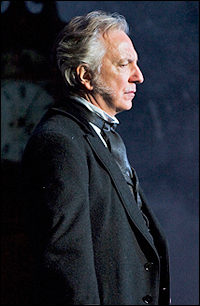*
Ask Playbill.com answers your (and sometimes our own) theatre-related questions. To ask a question, email [email protected]. Please specify how you would like your name displayed and please include the city in which you live.
 |
||
| Alan Rickman in John Gabriel Borkman. |
||
| photo by Ros Kavanagh |
First-timers at the Harvey Theater can't help but notice that the building — the entryway, downstairs lobby and the auditorium itself — look like a bombed-out relic from postwar Berlin. This is not because the Brooklyn Academy of Music ran out of money when renovating the 106-year-old vaudeville house. The interior design (or lack thereof) is entirely on purpose. But before we explain that bold design choice, some history first. The structure first opened as the Majestic Theater on Aug. 29, 1904, a time when downtown Brooklyn and its environs boasted several fine legitimate theatres. The Majestic sat 1,828 — a whopping number even by today's Broadway standards. The premiere production was The Wizard of Oz featuring Montgomery and Stone, Anna Laughlin and Lotta Faust. Over the course of the 1900s it would play host to vaudeville, light comedies, drama, Shakespeare, opera, film, dance, concerts, and contemporary performance art. It was also a tryout house for shows headed to Broadway, among them When Johnny Comes Marching Home, Noel Coward’s Home Chat, Betty Love, The Love Song, and Willy Howard's Sky High. Among the stars that appeared at the Majestic were Katherine Cornell and Sir Johnston Forbes-Robertson.
In October of 1942, the theatre was renovated and reopened as a first-run movie house by Leon Siritsky and his two sons, Joseph and Salamon, wealthy Parisian showmen who were forced to flee their theatres in France to escape the Nazi invasion. But by 1968, it, and the Strand next door, had closed, like many of the other Brooklyn theatres.
After lying dormant for nearly two decades, the Majestic and the Strand were targeted by the City for renovation as part of Brooklyn's plan to revitalize its downtown area. At the same time, BAM president and executive producer Harvey Lichtenstein was casting about for a place suitable to stage Peter Brook's nine-hour production of The Mahabharata. To enter the shuttered Majestic, Brook and Lichtenstein, in 1986, placed a ladder against the façade and climbed through a broken window on the second floor. According to BAM, the theatre had suffered extensive water damage, plaster was falling off the walls, the wooden stage floor was crumbling, and the roof leaked. Nevertheless, Brook told Lichtenstein the Majestic would be the perfect place to stage his production.
Peter Brook and his associate Jean Guy Le Cat modeled the theatre on their venue in Paris, Les Bouffes du Nord. The house was reconfigured to seat about half of its former capacity (roughly 900) allowing for a more intimate theatre experience as well as more lobby space. As for the shell of the theatre's auditorium, it was decided to leave it as is. The idea was to create a tangible link between the BAM Majestic Theater’s history and the theatre's future. (The Strand, meanwhile, became a bowling alley.)
BAM's spokesperson Sandy Sawotka said, "To my knowledge, we have no plan to change the design aesthetic, but we plan future improvements with regard to seating and access to seating."
Archivist Sharon Lehner confirmed that there were definitely no plans to change the look of the place. "They loved the ruinous look of it," she said, recalling the theatre's restoration, "and that you can't sit in the theatre without being reminded of its history. In the beginning, I think they did intend a 'phase two' renovation. But the more time they spent time in the space, the more they realized how much they liked it just the way it is."
The unfinished look of the interior, however, can be somewhat deceptive. "If you look at it," said Lehner, "you'll see there are parts that are 'as found,' and there are other parts that were correctly shored up or boarded up, fixed up, and then distressed to match the 'as found' stuff."
BAM officials routinely field inquiries from first-time patrons asking when the work on the house is going to be completed. "Some people get it right away," said Lehner. "And other people wonder when it's going to be finished."











